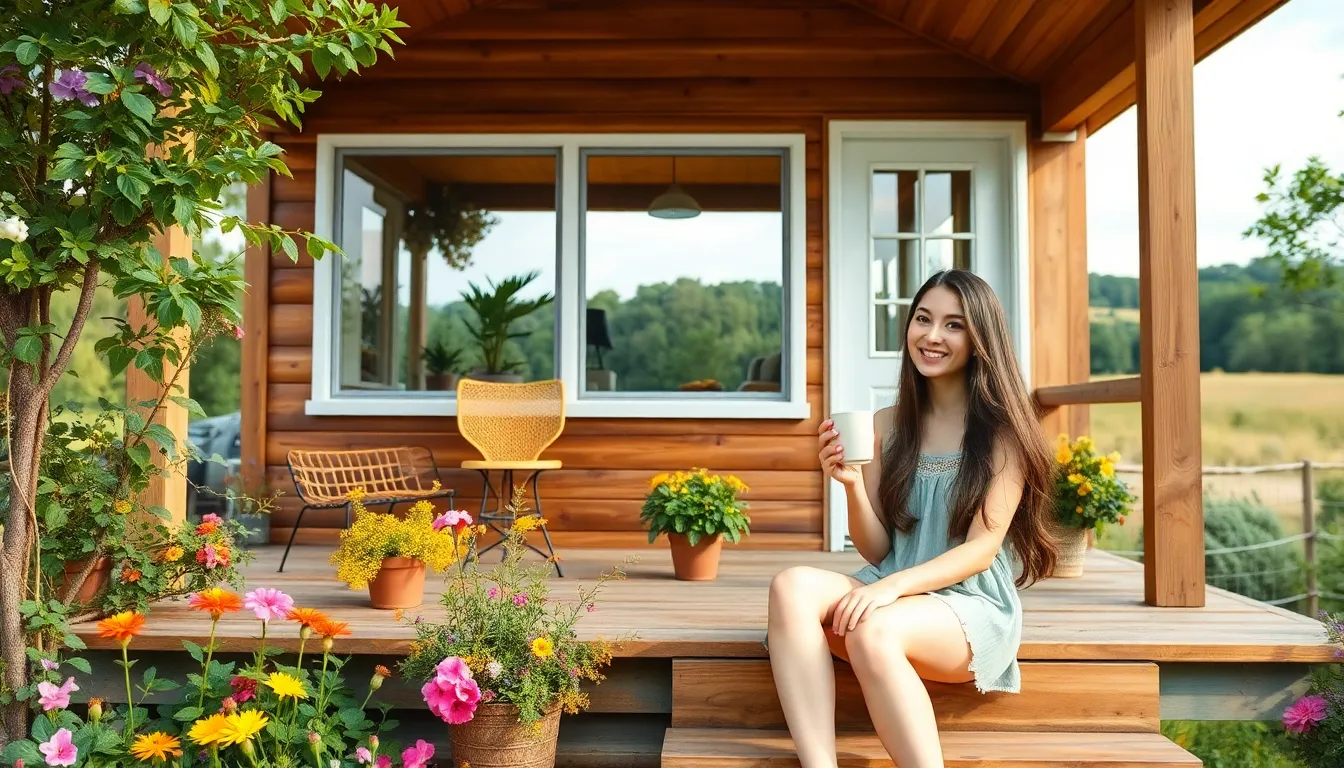Table of Contents
ToggleImagine living in a space so small, it makes a cozy blanket fort look like a mansion. Welcome to the world of tiny house smart homes, where every square inch is optimized for comfort and efficiency. These pint-sized paradises aren’t just about downsizing; they’re about upgrading to a lifestyle that’s as clever as it is compact.
Overview of Tiny House Smart Homes
Tiny house smart homes blend modern technology with compact living, enhancing both convenience and efficiency. These homes prioritize smart systems for lighting, climate control, and security, ensuring optimal resource management. Many homeowners choose energy-efficient appliances and fixtures, which significantly reduce utility bills and environmental impact.
Innovative designs often incorporate multi-functional furniture that maximizes space without sacrificing comfort. Homeowners can take advantage of smart home devices, such as voice-activated assistants and IoT integration, to streamline daily tasks. For example, smart thermostats learn user preferences, adjusting temperatures automatically to maintain comfort while conserving energy.
Security features, such as smart locks and surveillance cameras, offer peace of mind in smaller living environments where safety concerns may arise. Lighting systems allow for remote adjustments, enabling users to create ambiance or deter intruders when away. Additionally, these homes often utilize smart water management systems to minimize waste and track usage.
Personalization plays a significant role in tiny house smart homes. Residents Customize features to enhance their daily living experience. Space-saving solutions combined with advanced technology create an environment that’s not only functional but also promotes a minimalist lifestyle, encouraging intentional living.
Overall, the integration of smart technology in tiny house designs supports a growing trend towards sustainability and efficiency, appealing to those seeking a simpler yet connected way of life.
Benefits of Tiny House Smart Homes
Tiny house smart homes offer significant advantages, enhancing the living experience through sustainability and financial savings.
Eco-Friendly Solutions
Smart homes prioritize eco-friendly solutions, promoting sustainable living. Energy-efficient appliances reduce electricity consumption and minimize environmental footprints. Solar panels provide renewable energy, often covering a substantial portion of energy needs. Smart thermostats optimize heating and cooling, adjusting based on occupancy and weather patterns. Water-saving fixtures also play a crucial role, significantly cutting down water waste. These features contribute to reduced carbon emissions, supporting an eco-conscious lifestyle. Utilizing materials with low environmental impact during construction further reinforces sustainability in these compact spaces.
Cost Efficiency
Cost efficiency significantly attracts homeowners to tiny house smart homes. Lower overall square footage translates to reduced construction costs. Smart technology minimizes utility expenses, with energy monitoring systems tracking usage patterns. Homeowners experience savings from energy-efficient appliances and smart irrigation systems maintaining gardens without excess water use. Maintenance costs decrease as smaller living spaces require fewer resources and less frequent repairs. Many homeowners find that financing a tiny house smart home becomes more manageable, given the lower associated costs. Overall, the combination of reduced expenditure and smart investment makes owning these homes financially appealing.
Essential Smart Home Features
Tiny house smart homes incorporate essential technology features to enhance convenience and efficiency. The integration of smart systems facilitates a seamless living experience in compact spaces.
Integrated Home Automation
Integrated home automation systems simplify daily tasks by allowing residents to control various devices through a single interface. Smart assistants enable voice commands, managing lighting, climate, and entertainment systems effortlessly. Automation schedules can adjust preferences based on occupancy, enhancing both comfort and energy efficiency. Homeowners benefit from compatibility with diverse smart devices, making customization straightforward. Furthermore, mobile apps offer remote access to critical systems, enabling control from anywhere. This ability to manage home functions increases both convenience and security for tiny house dwellers.
Energy Management Systems
Energy management systems play a crucial role in tiny house smart homes. Smart thermostats automatically adjust temperature settings based on usage patterns, leading to significant energy savings. Monitoring energy consumption in real-time empowers residents to make more informed decisions about their usage. Solar panel integration often complements these systems, providing renewable energy sources that reduce dependence on the grid. Energy-efficient appliances, when paired with smart technology, further decrease utility bills and carbon footprints. Overall, prioritizing energy management enhances sustainability and lowers costs for tiny house owners.
Popular Tiny House Smart Home Technologies
Tiny house smart homes incorporate various technologies that enhance efficiency and comfort. Homeowners increasingly rely on innovations to create a connected lifestyle.
Smart Appliances
Smart appliances streamline daily tasks in tiny house smart homes. Energy-efficient refrigerators, ovens, and washers not only reduce energy consumption but also offer remote monitoring features. Residents often utilize apps to control these devices, allowing them to start or adjust settings from anywhere. Additionally, many smart ovens provide guided cooking options, ensuring meals are prepared to perfection. Integrated sensors in some appliances detect when cleaning is needed, prompting action that maintains optimal functionality. Smart appliances ultimately contribute to convenience while minimizing environmental impact.
Home Security Systems
Home security systems in tiny houses enhance safety and peace of mind. Smart locks allow for keyless entry, enabling homeowners to control access through mobile devices. Surveillance cameras offer real-time monitoring, alerting residents of any unusual activity. Systems often integrate with smart home hubs, allowing for centralized control of security features. Motion sensors not only detect movement but can also be programmed to trigger lights, further increasing security. Many solutions support remote viewing, letting owners check on their property anytime. Innovative security technologies adapt to the unique needs of tiny living spaces, ensuring protection without compromising on convenience.
Challenges of Implementing Smart Technology
Smart technology implementation in tiny house smart homes presents unique challenges. Space restrictions affect the installation and use of smart devices, necessitating careful planning.
Space Limitations
Limited square footage impacts choices regarding technology. Compact living often restricts the number of devices and their placement. Homeowners may find it difficult to accommodate large appliances or advanced systems due to these constraints. Multi-functional devices emerge as a solution in these scenarios. They maximize functionality without taking up extra space. It’s crucial to prioritize essential features that offer the best utility for homeowners in tiny houses.
Technology Compatibility
Ensuring compatibility among technologies adds another layer of difficulty. Different brands often produce devices with varying protocols, leading to integration challenges. Homeowners face obstacles when coordinating systems like lighting and climate control if they include products from multiple manufacturers. Researching compatible devices becomes essential for seamless functionality. Investment in a central smart home hub simplifies management and enhances ease of use. Selecting devices that follow common standards helps streamline installation and operation.
Tiny house smart homes represent a transformative approach to modern living. By integrating smart technology with efficient design, these homes provide a unique blend of comfort and sustainability. Homeowners can enjoy lower utility bills and a reduced environmental footprint while embracing a lifestyle that prioritizes convenience.
The innovative features of tiny house smart homes enhance daily living and offer peace of mind through advanced security systems. As more individuals seek to simplify their lives, the appeal of tiny house smart homes continues to grow. Embracing this trend not only supports financial savings but also fosters a deeper connection to eco-friendly practices. With careful planning and the right technology, tiny house living can be both smart and fulfilling.



